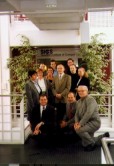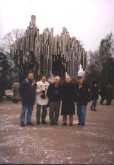<< Back to the contents of "About NHH"
Experience abroadThe National Hosts - as it is also indicated by their names - operate in their own countries. But they can hardly dispense with international relationships, experience abroad and co-operation with their fellow organisations. It is necessary to gather the best practices. Dr. Zsolt Balassy, the Managing Director of the National Host of Hungary said the Society assisted its members in the gathering of such experience. At the end of last year, a group attended a conference in Helsinki to evaluate the IST program, while another group collected Swedish examples for the development of the Host's demonstration laboratory. Visit to the "Swedish Silicon Walley""We visited the National Host of Sweden in late October 1999", said the managing director of the Host. "Mrs. Bárány Gabriella Süle and Dr. Edit Halász represented Pantel and Ericsson respectively and I represented the National Host of Hungary during the visit whose aim was the gathering of experiences. Our hosts work in the 'Swedish Silicon Walley', at the Swedish Institute of Computer Sciences in Kista near Stockholm, in the building of the computer research institute of the academy. The town is a scene of experiments with the latest computer technologies. There are university buildings and research institutes in the town, including the large research centres of Ericsson and Nokia. Our hosts received us in the headquarters and organised a full-day comprehensive program for us. Our Swedish partners have achieved outstanding results in image processing, the development of videoconferencing systems, the transmission of information via high-speed networks and in network connection. We could see the rarely seen, exceptional results of image communication technologies at the Institute. They showed us a number of excellent solutions that neither of us had seen similar ones before. We can take them as an example in developing our own demonstration place, the demo lab. They showed us three laboratories equipped with videoconferencing capabilities. One of the studios was apparently designed for the demanding user of the information society who is impressed by the experience of space rather than for those interested in technology itself. The design of the room is very nice. The three large screens are placed in a semicircle and can be used in conjunction for projections offering continuous space experiment or they can be used independently. The excellent acoustics of the place is ensured by hidden microphones. The position of the camera is not conspicuous either. It had a fully natural effect that the two extreme screens showed our partners, while the central screen showed ourselves. The superior quality of the high-speed ATM video communications connection was directly evident even to non-professionals. One of our partners was shown at the Göteborg University, while the other was in the laboratory of the research institute beyond the polar circle thousands of kilometres away. Excellent, studio quality pictures were broadcast from the inside and environs of the snow hut as well. No sound retardation, picture distortion, mistake or uncertainty was noticed at all. We have never seen such a high-quality videoconferencing system, although we have visited numerous Hungarian and international presentations. A direct contact was established with the colleagues of an American research institute by a videoconferencing system in another room. We had a conversation with them and asked what sort of research projects they were working on. We were impressed by the positioning of the cameras. Both parties could control all details of the positioning of the cameras. For example, another camera was used for paper-based presentations. Though the quality of video transmission was inferior to that of the ATM system, it was far superior to the systems seen in Hungary. The third system was a traditional screen covering a whole wall surface but it was interesting for something else. It was placed in the canteen and any employee could operate it and used it for access to the internet, watching TV or for entertainment purposes. We were shown several technical details of the systems and we also talked about the application of the information society technologies in Sweden, of course. The Swedish education exampleWe were told that the Government devoted particular attention to organising the continuous education of citizens and providing equal opportunities to those living far away from cities and large towns. This is not easy because the country stretches along a great distance. Either the Government would be required to build and maintain considerably more schools or the students would be required to travel unbearably great distances or move to another place temporarily if the program were implemented by traditional methods. Therefore a public education experiment was started in the 1960s using contemporary technologies. Since then, they have found the applicable means, an ISDN-based low-speed videoconferencing system, and built it throughout the whole country. Sixty-two per cent of the universities and colleges joined the program. The normal lectures are recorded with fixed cameras placed in the classrooms. The images, voice and signals are transmitted to the administrative institutions of the settlements that the students will visit according to their timetables to follow the selected lectures on the screen. They can collect the appropriate teaching material from multiple universities. They can take exams, they can graduate from specific bodies of knowledge but the times of their attendance are not so fixed as in a traditional educational institution and they can access various educational and postgraduate opportunities at their own places of residence. The Government support the students by providing the required bandwidth for data communication and by paying the telecommunications charges. This is a living example of how the Government can use the potentials of the information society technologies to attain the goals that were set several decades ago. Results of the information society technologiesIn addition to popularising the various foreign organisations, the Host contributes to the understanding of the results of research and development programs related to the building of the information society (IST). We can promote the success of much more Hungarian tender applications if we help the staff of our member organisations, engaged in the writing of tender applications, attend the relevant international events and acquire more thorough knowledge of the goals and ways of implementation of the program and the keys to the success of the best performing applicants. The conference and exhibition showing the results of the IST were organised in November 1999 in Helsinki. The Society could finance the participation of the representatives of four member organisations. The conference was attended by Ferenc Baumann of the Technical University of Budapest, Dr. Gábor Borbély of the College for Telecommunications of Győr, László Horváth of the LTO Federation and Dr. György Tormási of Antenna Hungária. The participation of Dr. Zsolt Balassy, who is also a member of the management committee of the IST program, was financed by the EU. Dr. Edit Halász of Ericsson also attended the event on behalf of the Society. Our hosts included EU officers, the motivators of the information society, and the people of TEKES, an organisation similar to the Hungarian OMFB (National Board for Technical Development) that plays a significant part in the operation of the National Host of Sweden. The lectures, the presentation of successful innovations, the delivery of the prizes and the opportunity of meeting the winners of previous prizes proved that the European Union was committed to competing with US research and development and to developing an independent image for itself. Substantial work was done in the 5th framework program as well which IST is a part of. The high level of the program is shown by the fact that more than five thousand applications were received last year and three hundred of them were accepted for financing. All the major lecturers and topics were represented at the event that lasted for several days. There were lectures with technical and sociological approaches, discussing the various aspects of the topic from the expected results of development to the risks to be avoided. There were reports on various innovations that may arouse interest even in this quickly developing industry. Nokia made a remarkable announcement, outlining a new vision. The participants were informed of the introduction of WAP services that have become widely known during the short time since then and are now available in Hungary as well. The results of the best ten innovations were praised at the awards ceremony. It is interesting to note that a Hungarian product, a translation program called intelligent mouse, was also ranked among the top ten award-winning products. This imaginative product has won several prizes in Hungary so far. When the mouse is positioned on a word its foreign language equivalent pops up automatically. The winners of last year were also invited to the ceremony. They told how their achievements had been recognised in their home countries since the winning of the prize and they also spoke about the development of the business venture based on the innovation. Everybody reported on a great success. This is true for each tender topic but the top ten can rely on a continuous advertising campaign supported by the EU that also contributes to the success of the business. It was a remarkable lesson of the things seen and heard that successful participation in an EU tender may help not only to raise funds for research but provide considerable marketing support as well. We could not only hear of the most important research results but we could see or even touch them at the exhibition. Plenty of innovations were displayed from self-propelled robots to 3D TV screens. There were also social programs, meetings and receptions like at every large-scale international conference and we had an opportunity of visiting the sights of the Finnish capital as well. We were greatly impressed by the things we had seen and heard. With a well positioned technology, Finland has transformed from an agricultural country into a great industrial and economic power, a world leader in mobile communications, recognised all over Europe. Hungary can learn from its progress. It would be worthwhile to process the development of its success story and adopt its "recipes". Those attending the Helsinki conference were on the same opinion that the visit inspired and encouraged the writing of tender applications. They acquired valuable information and useful contacts. They believe that their companies or institutions will make good use of the experience. Copyright © MNH 1999 |


